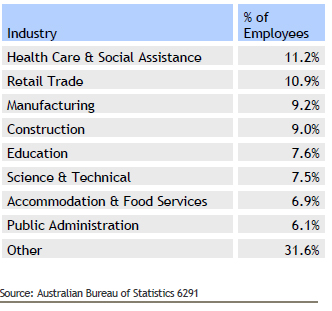Unemployment defying the economic cycle
Although Australia’s economic growth rate is admirable against the backdrop of the Global Financial Crisis, the latest economic growth numbers for the December quarter confirm that activity is still soft. Based on past economic cycles, a downturn in the rate of annual economic growth, to just 0.5% at a time when population growth is above 2%, would be expected to generate a material rise in unemployment.

As can be seen in the chart above, the economic downturns in the early 1980s and early 1990s generated a jump in unemployment of more than 4%, and pushed the rate of unemployment above 10%. Given that unemployment was coming off such a low base, it may have been reasonable to expect a similar magnitude of increase in unemployment of around 4% in the current cycle - even though the rate of decline in economic growth has not been as great as the past 2 downturns.
It now appears that unemployment will peak at a level substantially below what was previously expected. From a low point of 3.9% in early 2008, the unemployment rate is currently 5.7%. Although future increases are likely, the fact that employment growth and job vacancy growth numbers are now positive, suggests that any increase from here may only be very moderate.
What is different this cycle?
One feature of the current economic cycle has been the tendency of firms to reduce the hours worked by employees, rather than shedding workers completely from employment. In the year to September 2009, the number of hours worked in the economy declined by 2.3%. However over the same period, the number of workers employed rose by 0.1%. Hence there has been a material fall in the average number of hours worked per employee. This has been facilitated to an extent by a rise in the incidence of part time employment.
Another longer-term change that has characterised the Australian economy over the past 2 decades has been a rise in the proportion of employees working in industries that could be described as being less cyclical or “recession proof”. In 2009, the health care sector became the largest employer in the Australian economy. The table below shows the percentage of workers employed in each of the main industry groups.

Of the top 5 employing groups, education and health are likely to be regarded as relatively non-cyclical. Retail and construction have been directly targeted by the Commonwealth Government via stimulus programs.
Some of the more cyclical sectors have declined in relative employment importance over time. Manufacturing, for example, represented 15% of workers at the beginning of the 1990s and has since fallen to make up only 9% of the total.
Hence the combination of more flexible working hours and shifts in the industry composition of labour may have led to a situation in Australia where unemployment has become less influenced by economic cycles. If this is so, the overall longer-term stability of the Australian economy may have also increased.

